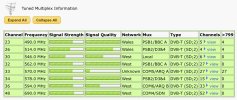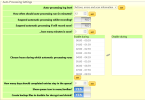I have a Humax HDR Fox T2 (Cust FW 3.13) which has been suffering from HD picture break up for 18 months at least. The problem occurs when watching live HD TV which effectively rules out a problem with the drive. It might happen once or twice during a 1 hour program, and the next day I might never see the fault all evening. Of course, once the problem has been witnessed live, hitting rewind will show that the live picture break up has been recorded too.
I had already replaced the drive before I realised that the random break up occurs on live TV.
I never see a problem with SD recordings.
I’ve checked the state of 12V, 5.8V and 5V rails and all are good. Nevertheless I replaced all power supply electrolytics, but the problem persists.
I am receiving HD TV on PSB3 mux C35- (585.8MHz) from Winter Hill but the HDR Fox T2 is set to C35 (586.0MHz). Prior to June 2022 HD TV muxes from Winter Hill were com7 on C55 (746.0MHz) and com8 on C56 (754.0MHz) – no offset channels.
Current C35 signal strength is 71% and quality is 100% - I’m assuming that the quality dives when the picture breaks up but there’s no way of monitoring signal information for hours on end.
I’ve tried replacing the loft distribution amplifier, downlead, patch lead and using different gain outputs (8dB, 12dB and 16dB) on the stepped gain distribution amplifier but nothing makes any difference.
I’ve got to think that the momentary break up is due to the fact that the tuner is programmed to receive on 586.0MHz and it momentarily loses lock on the 585.8MHz transmitted frequency.
Prior to June 2022 there was no offset between transmitted and programmed receive frequencies for HD muxes from Winter Hill.
Can anyone tell me if the 200KHz discrepancy between frequency of transmission and programmed frequency of receiver might cause the tuner to momentarily lose lock?
If so, can anyone suggest a tweak to improve tuner lock?
I had already replaced the drive before I realised that the random break up occurs on live TV.
I never see a problem with SD recordings.
I’ve checked the state of 12V, 5.8V and 5V rails and all are good. Nevertheless I replaced all power supply electrolytics, but the problem persists.
I am receiving HD TV on PSB3 mux C35- (585.8MHz) from Winter Hill but the HDR Fox T2 is set to C35 (586.0MHz). Prior to June 2022 HD TV muxes from Winter Hill were com7 on C55 (746.0MHz) and com8 on C56 (754.0MHz) – no offset channels.
Current C35 signal strength is 71% and quality is 100% - I’m assuming that the quality dives when the picture breaks up but there’s no way of monitoring signal information for hours on end.
I’ve tried replacing the loft distribution amplifier, downlead, patch lead and using different gain outputs (8dB, 12dB and 16dB) on the stepped gain distribution amplifier but nothing makes any difference.
I’ve got to think that the momentary break up is due to the fact that the tuner is programmed to receive on 586.0MHz and it momentarily loses lock on the 585.8MHz transmitted frequency.
Prior to June 2022 there was no offset between transmitted and programmed receive frequencies for HD muxes from Winter Hill.
Can anyone tell me if the 200KHz discrepancy between frequency of transmission and programmed frequency of receiver might cause the tuner to momentarily lose lock?
If so, can anyone suggest a tweak to improve tuner lock?





